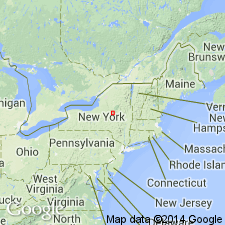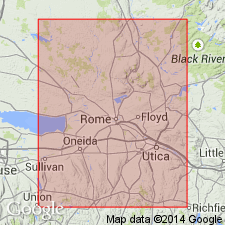
- Usage in publication:
-
- Poland limestone member
- Modifications:
-
- Named
- Dominant lithology:
-
- Limestone
- AAPG geologic province:
-
- Appalachian basin
Summary:
Name Poland limestone member proposed for middle member of Denmark formation. Consists principally of dense fossiliferous limestone with intercalated calcareous shale southeastward to Newport, passing wholly into sparsely fossiliferous argillaceous calcilutite and shale of the "Dolgeville" facies at East Canada Creek, and ultimately into black shale at Canajoharie. Includes black dense resistant limestone at its base (not exposed at Trenton Falls). In various sections contains a metabentonite near the base, two higher in unit, and a fourth at contact with overlying Russia limestone member (new). Contrasts with underlying Rathbun limestone member (new) by lack of coquina beds. Thickness about 60 ft. Age is Middle Ordovician (Mohawkian).
Source: GNU records (USGS DDS-6; Reston GNULEX).

- Usage in publication:
-
- Poland Member
- Modifications:
-
- Overview
- Revised
- AAPG geologic province:
-
- Appalachian basin
Summary:
Poland Member of Denley Limestone (Trenton Group) includes calcilutites and interbedded dark shales. The calcilutites contain the trilobites ISOTELUS and FLESICALYMENE and orthocerid nautiloids. The informally named City Brook bed (TROCHOLITES bed of Kay, 1953) defines the base of the Poland. It is an intensely bioturbated pack- to wackestone. It is exposed from the Trenton Falls area to near Countryman, NY. Bed is named for the excellent exposure on Wolf Hollow Creek (City Brook) just above City Falls. Southeast of Little Falls, the City Brook bed is cut out by erosion. Bed may be correlative with the Camp Member of Chenoweth (1952), in which case the name Camp would have precedence. The Poland overlies the Rathbun Member of the Sugar River and underlies the North Gage Road bed (new, informal) at the base of the Russia Member of the Denley.
Source: GNU records (USGS DDS-6; Reston GNULEX).

- Usage in publication:
-
- Poland Member*
- Modifications:
-
- Overview
- Age modified
- AAPG geologic province:
-
- Appalachian basin
Summary:
Denley Limestone and its Glendale and Poland Members are used in this report. Age is refined to Champlainian (Shermanian).
Source: GNU records (USGS DDS-6; Reston GNULEX).
For more information, please contact Nancy Stamm, Geologic Names Committee Secretary.
Asterisk (*) indicates published by U.S. Geological Survey authors.
"No current usage" (†) implies that a name has been abandoned or has fallen into disuse. Former usage and, if known, replacement name given in parentheses ( ).
Slash (/) indicates name conflicts with nomenclatural guidelines (CSN, 1933; ACSN, 1961, 1970; NACSN, 1983, 2005, 2021). May be explained within brackets ([ ]).

